 BUY IT AT AMAZON: CLICK HERE
BUY IT AT AMAZON: CLICK HERE
STUDIO: Warner Bros.
MSRP: $29.98 RATED: R
RUNNING TIME: 154 minutes
SPECIAL FEATURES:
• Theatrical Film With Commentary by director Edward Zwick
• Deleted Scenes with commentary
• History vs. Hollywood: The Last Samurai
• Tom Cruise: A Warrior’s Journey
• Edward Zwick: Director’s Video Journal
• Making an Epic: A Conversation with Edward Zwick and Tom Cruise
• A World of Detail: Production Design with Lilly Kilvert
• Silk and Armor: Costume Design with Ngila Dickson
• Imperial Army Basic Training
• From Soldier to Samurai: The Weapons
• Japan Premieres – Tokyo & Kyoto red carpet
• Theatrical Trailer
The Last Samurai was Warner’s big Oscar hopeful last year. It had a tremendous budget, starred one of the most reliable and bankable stars of the past twenty years, was based on a beloved book, and was directed by a guy known for lavish epics. Sadly, it didn’t make the financial and emotional connection it was expected to. Now that it’s hitting the digital frontier it’s time to gauge if the first glance was a proper one.
The Flick
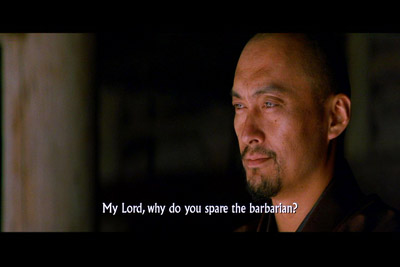
Every culture has their own slang for jerking off…
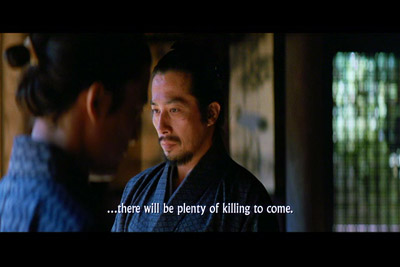
…but few explain the reasons such an act is taboo…
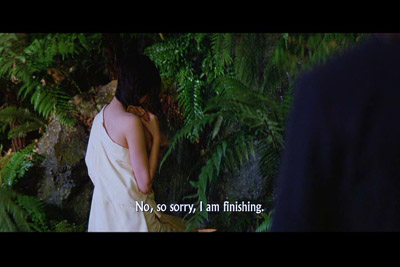
…and even fewer have discovered that it’s more polite to share the task.
The new breed of sprawling Hollywood epics share many traits: lavish production values, big stars and loads of familiar character actors, sweeping scores, and the most cutting edge editing and special effects technology money can buy. There’s a certain corporate feel to them. The lineage can be traced through Dances With Wolves, Braveheart,Gladiator, and right into The Last Samurai. They are quite simply… immaculate. They entertain, excite, and wring emotions but sometimes buckle under repeated viewings and too often I feel like I’m being told as a viewer that “this is important and you must respond to this” instead of falling into the graceful arms of the storytellers willingly.
The Last Samurai feels like a film just a few notches away from being a classic but one whose flaws end up defining it.
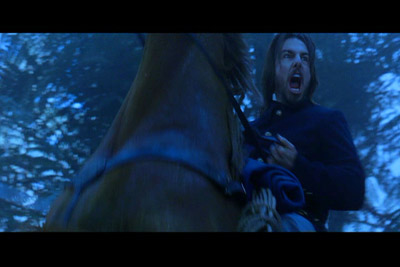
“Wait a minute… THIS ISN’T LEE HORSLEY!”
The story focuses on the fictional character of Nathan Algren (Cruise), an American soldier known for his skills on the battlefield who is recruited to assist the Japanese army in modernization. Along the way, he is captured by the samurai warriors and slowly begins to realize the truth behind the conflict and finds himself in the process. Honor, duty, loyalty, change, culture, and many other important matters are addressed and the film succeeds best during the quieter moments Algren shares with his newly discovered Japanese allies. The end of the 19th century is very well represented here as a culture built on tradition adapts to modern ways, it’s powerful stuff but the scenes that should be the most memorable often end up the least affecting, especially the film’s waning moments that reek of familiarity.
When the film shines is showcasing the transformation of Algren from a drunken mercenary to a respectful crusader alongside his Japanese friends and most of that credit has to go with director Edward (Glory,Legends of the Fall) Zwick’s willingness to let his Asian cast members share the spotlight with his superstar.
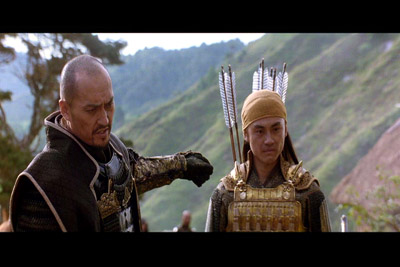
“Take Shep here for instance. Each night he is shot in the spine by the arrows of the Ceiling Ninja™ but still he returns to don his ancient doo rag and help me lay the groundwork for KOEI’s Sega Genesis strategy games 100 years in our future.”
As the samurai of the title, Ken Watanabe steals the film in a performance of grace, dignity, and restraint. His Katsumoto is such a noble and compelling character that I couldn’t help but wish this was a different film. Were his character the focus and not Algren, this would be a classic and there’d be no Dances With Katanas comparisons. Anchoring the film with an American character might be good for business and it may reflect some semblance of history, but it doesn’t carve its own foothold in the genre. Were the film not a star vehicle for Tom Cruise (who does a really good job here, actually) and focused more on a nation’s loss of its history and the fallout the samurai culture endured, something timeless and more evocative would have been the result.
Watanabe has a presence onscreen I haven’t seen in a long time. It reminds me of the first time I really saw Russell Crowe or Chow Yun-Fat in their element. Everything else on the screen is irrelevant. Were it not for his amazing work, the considerably powerful work of Hiroyuki Sanada as the other lead warrior might have been more widely recognized. The entire Asian contingent of the cast is stunning, in fact.
With that said, the film suffers due to its American connection. It’s a shame too, because I’m a big fan of Tom Cruise. The star of this film isn’t Cruise, at least it shouldn’t be. The star of the film is Old Japan and her people. The presence of a high wattage Hollywood face ultimately detracts from that.
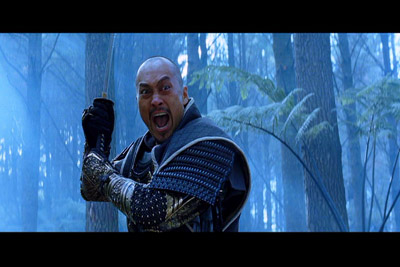
I’m not going to say that Watanabe’s promotional campaign for the Oscars was intimidating, but…
What Cruise does bring to the film is energy. If there’s an actor who has never sleepwalked through a role, it’s him. Aside from a bit of questionable work in the film’s early moments, Cruise plays Algren as an explosive and dangerous man but it’s his acclimation and almost awe at the Japanese way of life gives the actor some of his richest opportunities in years. Despite my disappointment with the film’s choice of focus, there’s no doubt the actor invested himself in the role. The fight sequences, primarily the ninja attack sequence and the street fight surprised me in how efficient and convincing Cruise was as a veritable ass kicker.
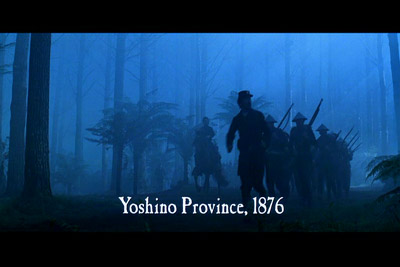
I think you’ll all agree that the Yoshino Province franchise got tired after the 1689th sequel.
Technically, the film is impeccable. The costumes are incredibly detailed and unique and the production design manages to feel both familiar and new. A lot of epic period films tend to show off too much, reveling in computer assisted scenes that showcase the setting but end up taking the audience out of the story. Here, there’s plenty of eye candy but the focus is always people.
Additionally, Edward Zwick is a craftsman to be reckoned with but a few decisions end up costing his film considerably. The usage of slow motion is a crutch as much as a benefit to the modern filmmaker. When used correctly, it allows the audience to feel in the moment or a storyteller to focus on the one important detail that has to be seen. In The Last Samurai, the slow motion sometimes sucks the momentum and energy out of a scene. Zwick used the technique to good effect in Glory, but here the speed is essential and its loss cuts the film’s edge.
The other two aspects of the film that don’t connect are the main climactic battle and the romantic subplot, rather important aspects of the narrative.
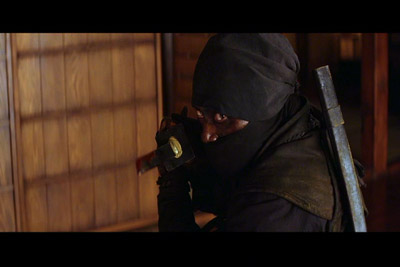
It’s so funny how the story of Ninja Guy Dan has been misinterpreted over the years.
No epic worth its salt is complete without a grand finale, but by the time this film is winding down the best moments are behind it. The aforementioned ninja attack sequence and street fight where Algren first puts his new skills to the test have a vitality that the big field skirmish at the end lacks. While it’s understandable that a clash of technology and more natural tactics is intentionally one sided and crushing, it seems like an afterthought. Factor in the recent surplus of incredible wide scale action sequences and this film doesn’t have that powerful third act it needs. When the resolution does come, it’s only successful because of the actors and the audience’s investment in the characters and not because of John Logan’s story, Hans Zimmer’s familiar but solid score, and Zwick’s eye.
The romantic subplot between Algren and Koyuki’s Taka character is barely touched upon, a fact that hamstrings it. Were the film to have committed one way or the other, the results would have been better. It’s already a bit of a contrivance that Algren would happen to become close to and in a sense take the place of the man he killed by way of ingratiating himself to the man’s wife and children. It’s a lot to ask. Then, to paint in broad strokes once that bit of disbelief is suspended is just plain wrong. You expect a payoff. You want a payoff. Otherwise, the issue shouldn’t have been broached.
It’s easy to pick apart a film that hundreds worked their asses on with the span of a few paragraphs, isn’t it? God, movie critics suck…
The Last Samurai is a good film that should have been a great one. It deserves a place on the shelf next to the James Clavell and Kurosawa films for its craftsmanship and performances but falls considerably short in delivering the emotional payoff those others are known for.
7.5 out of 10
The Look
This is a beautiful looking DVD.
The colors are crisp, the image free of defects, and John Toll’s gorgeous visuals presented in the finest manner possible. Seriously, this is a pristine looking disc and reference quality as the techies say. The thing that impressed me most, and it’s a small thing…
Sometimes films like these get a little “punch” on home video, a little added work on the presentation. Sometimes it’s incredibly successful and other times a bit jarring.
This film looks incredible, but the work is subtle. Look at Cruise’s maroon armor (not in the screen caps but on your television) and tell me that’s not the most sweet looking DVD in town.
10.0 out of 10
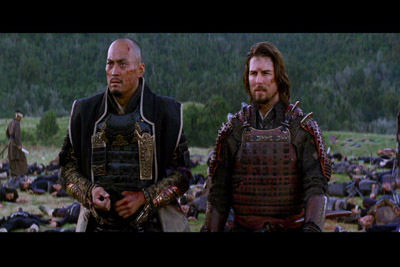
It is unknown whether the warriors were stunned that they survived despite 630 to 3 odds or because they’d mistaken the Kababuto family reunion for the army of their nemesis.
The Noise
This DVD delivers on yet another front. The audio presentation is the requisite 5.1 track, and it’s a beauty. The technical deliver of Zwick’s movie was never a concern and DVD allows for a really rich experience, especially in the percussive and sometimes haunting music and atmospheric effects. It’s a rather lyrical film and this track delivers it with a surprisingly discrete and delicate touch.
One of the better tracks in recent memory. Of course, when it needs to kick your ass it has no qualms either.
9.5 out of 10

Hank was forever thankful that someone had sent a rechargeable beard and mustache trimmer through the time portal for his personal grooming delight.
The Goodies
At first glance this looks like one of those incredibly robust DVD offerings. There’s a nice list of special features all across the back of the case but upon inspection I found a lot of them to overlap and deliver a less than comprehensive experience.
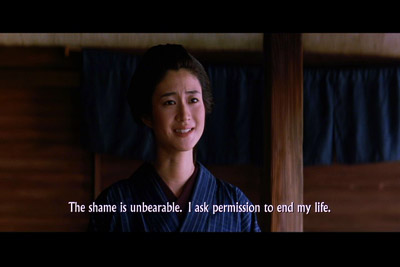
Remember the good old days when suicide bombers were cordial?
The central commentary track by Edward Zwick (the only special feature on the first disc) is educational and packed with insight but a pretty straightforward affair. The director obviously has passion and determination to spare, but it’s certainly not a very loose and fun track but rather a solemn and professional one. That’s not a hindrance, this isn’t a “fun” film. With that said, I tend to find his commentaries a little too slow moving to really recommend a listen. Fans of the film will certainly line up for it, but don’t expect the commentary track to win you over if you’re on the fence.
Tom Cruise didn’t contribute to the commentary track, but the second disc gets a lot of mileage from an extended conversation he had with Zwick while on set. It’s a nice, good looking conversation that was apparently something that was planned out and a cut above the usual EPK material slapped onto the format. The conversation is pretty good and Cruise does a good job of balancing his enthusiasm and respect for the material with the expected actorly things one’s supposed to say. Zwick does most of the talking, but it’s a pretty solid feature. The problem I had was when some of the other features also used material from this interview.
There’s short barrages of features about the costumes, production design, weapons, and a little rah-rah Tom Cruise piece, but none are as in-depth or comprehensive as the better documentaries we’re seeing on DVD. They’re certainly fine, just not outstanding. Additionally, there’s a nice but surprisingly short History Channel offering on the balance between the fact and fiction of The Last Samurai.
Zwick’s video journal’s a neat addition that features on-set footage with a voiceover by the director. It’s neat to see the actual photography happening and there’s a few nice moments that showcase John Toll or Tom Cruise in their element. My favorite part: When Zwick refers to two folks as “Japan Hands”. See, that’s our buddy Justin Waddell’s HALO characters’ name.
The other highlight is two deleted scenes, one of which being an absolutely cool decapitation. I see why it was culled, but you can simply never have enough decapitations in a film…
Overall, I expected it to be a super special edition and it was only a special edition but still a pretty solid affair.
7.5 out of 10
The Artwork
Normally, I’d fire a ton of bricks at this cover. See, it’s a floating head. But, I have to admit that it’s a really good shot of Cruise. He looks like he means business, and it’s a pretty nice collage if one can exist.
With that said, I really miss those eloquent one-sheets they used for the theatrical release. This is serviceable, but not as sexy and iconic as those. Why they cannot include double sided slip sleeves for these is beyond me. Why don’t they allow us to decide if we want the old or new artwork? It’d cost an extra half penny to them per disc most likely. Plus, since more and more studios are giving the inner card the shaft these days it’s the least they can do.
7.0 out of 10
THE FLICK: 7.5
THE LOOK: 10.0
THE NOISE: 9.0
THE GOODIES: 7.5
THE ARTWORK: 7.0
OVERALL: 7.7